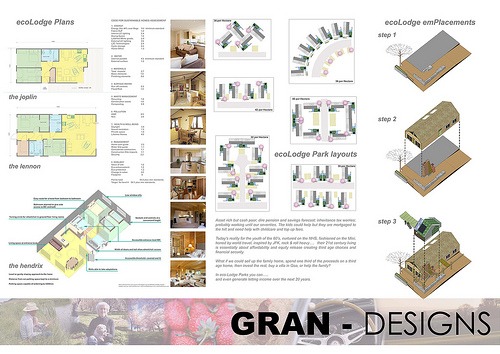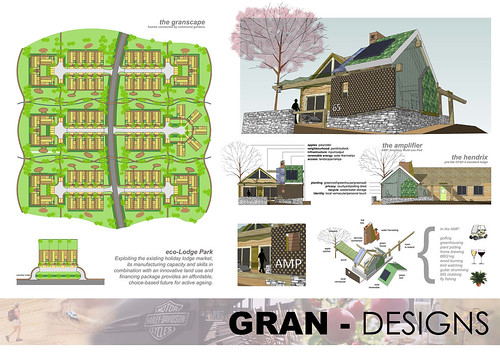The quality of supported housing for the 55+ market in the UK is a topic we’ve been discussing here at Axis Design a lot over the last few years. This year’s brief for the British Homes Awards gave us the opportunity to explore some of our ideas and show how we believe the industry could turn to existing housing solutions from the holiday home sector combined with improved landscape and infrastructure to meet the aspirations of retiring baby boomers.
Here’s our response to the Lifetime Homes challenge set by the British Homes Awards 2009 (click images for full size):
Eco Lodge Parks
Asset rich but cash poor; dire pension and savings forecast; inheritance tax worries; probably working until our seventies. The kids could help but they are mortgaged to the hilt and need help with childcare and top up fees.
Today’s reality for the youth of the 60’s, nurtured on the NHS, fashioned on the Mini, honed by world travel, inspired by JFK, rock & roll heavy…. their 21st century living is essentially about affordability and equity release creating third age choices and financial security.
What if we could sell up the family home, spend one third of the proceeds on a third age home, then invest the rest, buy a villa in Goa, or help the family?
In eco-Lodge Parks you can….. and even generate letting income over the next 20 years.
Thanks to Jez Sanders from Red Landscape for collaborating with us on this work. Although we didn’t make the shortlist we’re still very pleased with the concept and hope to get the opportunity to develop it in the future.
(see the full entry for further text)
The Eco Lodge Park (eLP)
Low cost, energy efficient, easily maintained and secure lodges suitably adapted to Lifetime Homes (see plans) laid out on a variety of site sizes, topography and shapes. The sites can vary from established waterside locales, derelict country house grounds to urban cleared land where the proximity of suitable retail, leisure and health facilities is the determinant.
They could even be used to augment the income of existing clubs/parks and courses.
Typically the lodges feature contemporary, flexible living spaces with two/three bedrooms (see plans) ramped access, car parking, decked living, fitted kitchens, en suite and family bathrooms. Each lodge or pair of lodges is supported by an AMP.
The AMP (Ancillary, Multi-use Pod) is a power & meter enclosure, rainwater storage, solar renewables, broadband conduit, recycled waste and BBQ. Externally it will reflect local vernacular and support trellised fruit/flower planting, internally it will amplify active ageing… golf buggy storage, potting shed, bird hide, rod, tackle and aqualung.
Lodge Parks would be temporary residential land uses similar to mobile homes, and annual holidays to visit the family or travel abroad could offer an opportunity for income from short term lettings. They could also be mixed use allowing for home working, community enterprises and local employment creation. The larger Eco Park sites would be managed by the Land owner and a Park Committee.
Eco Lodge Parks Land
Land typically contributes the same as build costs per plot, or more at lower densities. Adding £60-80k per lodge to the costs negates any equity released by sale, sometimes to the point where over 60’s mortgage finance is called for. The eLP proposes a shared equity approach where the land owner, typically an RSL or Local Authority, would provide varying sized sites (see plans), for a 10 to 20 year period. They would generate an annual rent of between 3% and 8% of open market value; say 80k to 200k.
The parks would be serviced with landscape and infrastructure with each emplacement contributing around 6k (250k per hectare).
Eco-Lodge Capital costs
Lodges come in variety of types but typically are 6m x 12m transportable modules, single storey, highly insulated and with suitable parking and amenity spaces provide a density between 30 and 40 per hectare. A typical new 72sm lodge is presently available at £55,000, VAT free, with previously owned units as low as £15,000. The Lifetime Homes modifications which we anticipate might add £5k. The Amp and CFSH renewables will add a further £10k.
Around 70k buys you a new two bedroom, third-age lodge, 10 year guaranteed, on a landscaped and serviced site belonging to the Local Authority/RSL. Land equity sharing on a temporary use for the next two decades and time enough for the baby boomer bulge to pass, and land values to fully recover.
Lodge owners have an asset which can be written down over 20 years, rented out /sold on, gifted to the kids or moved to any other UK lodge park setting should lifestyle/circumstances dictate.
Eco-Lodge Running Costs
- Lodge emplacements cost between 2k and 5k including annual maintenance costs.
- Moving fees are between £400 and £1200 should you resite your lodge to be nearer the family or your hobby/pastime.
- On larger sites we propose some emplacements left vacant to permit resident turnover.
- Renewables including heat recovery ventilation, air-based heat pumps, solar water, PV lighting and rainwater harvesting augmented by a wood burning stove will dramatically reduce energy bills. Lodges are rated at CFSH level 4.
Conclusion
Exploiting the existing holiday lodge market, its manufacturing capacity and skills in combination with an innovative land use and financing package provides an affordable, choice-based future for active ageing.



Fantastic concept. Love the future of design and the thinking it will become. Makes every area of design exciting and more innovative. Can’t wait for the next 5o years